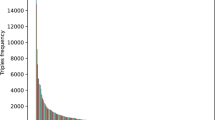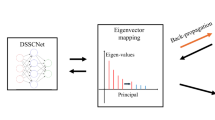Abstract
With the continuous development of information acquisition technologies, large-scale multi-view data increases rapidly. The enormous computational and storage complexity makes it very challenging to process these data in real-world applications. Most existing multi-view subspace clustering (MVSC) always suffers from quadratic space complexity and quadratic or even cubic time complexity, resulting in extreme limitations for large-scale tasks. Meanwhile, the original data usually contain lots of noise or redundant features, which further enhances the difficulty of the large-scale clustering tasks. This paper proposes a novel MVSC method for efficiently and effectively dealing with large-scale multi-view data, termed as tensorized anchor graph learning (TAGL) for large-scale multi-view clustering. Concretely, TAGL first projects the original multi-view data from the original space into the latent embedding space, where the view-consistent anchor matrix. Meanwhile, we establish the connection between the anchor matrix and the original data to construct multiple view-specific anchor graphs. Furthermore, these anchor graphs are stacked into a graph tensor to capture the high-order correlation. Finally, by developing an effective optimization algorithm, the high-quality anchors, anchor graph, and anchor graph tensor can be jointly learned in a mutually reinforcing way. Experimental results on several big sizes of datasets verify the superiority and validity of TAGL. Therefore, the proposed TAGL can efficiently and effectively handle large-scale data tasks for real-world applications.






Similar content being viewed by others
Data Availability
The datasets generated during and/or analyzed during the current study are available from the corresponding author on reasonable request.
References
Wang S, Liu X, Zhu X, Zhang P, Zhang Y, Gao F, Zhu E. Fast parameter-free multi-view subspace clustering with consensus anchor guidance. IEEE Trans Image Process. 2021;31:556–68.
Dai J, Ren Z, Luo Y, Song H, Yang J. Multi-view clustering with latent low-rank proxy graph learning. Cogn Comput. 2021;13(4):1049–60.
Li X, Sun Q, Ren Z, Sun Y. Dynamic incomplete multi-view imputing and clustering. In: Proceedings of the 30th ACM International Conference on Multimedia. 2022. p. 3412–20.
Kang Z, Lin Z, Zhu X, Xu W. Structured graph learning for scalable subspace clustering: From single view to multiview. IEEE Trans Cybern. 2021;52(9):8976–86.
Kang Z, Xu H, Wang B, Zhu H, Xu Z. Clustering with similarity preserving. Neurocomputing. 2019;365:211–8.
Lin Z, Kang Z, Zhang L, Tian L. Multi-view attributed graph clustering. IEEE Trans Knowl Data Eng. 2023;35(2):1872–80.
Li X, Sun Y, Sun Q, Ren Z. Consensus cluster center guided latent multi-kernel clustering. IEEE Trans Circuits Syst Video Technol. 2022;1–13.
Liu X, Liu L, Liao Q, Wang S, Zhang Y, Tu W, Tang C, Liu J, Zhu E. One pass late fusion multi-view clustering. In: International Conference on Machine Learning. 2021. p. 6850–9.
Huang S, Tsang IW, Xu Z, Lv J. CGDD: Multiview graph clustering via cross-graph diversity detection. IEEE Trans Neural Netw Learn Syst. 2022;1–13.
Liang Y, Huang D, Wang CD. Consistency meets inconsistency: a unified graph learning framework for multi-view clustering. In: 2019 IEEE International Conference on Data Mining. 2019. p. 1204–9.
Luo S, Zhang C, Zhang W, Cao X. Consistent and specific multi-view subspace clustering. Proc AAAI Conf Artif Intell. 2018;32:3730–7.
Cao X, Zhang C, Fu H, Liu S, Zhang H. Diversity-induced multi-view subspace clustering. In: Proceedings of the IEEE Conference on Computer Vision and Pattern Recognition. 2015. p. 586–94.
Wang X, Guo X, Lei Z, Zhang C, Li SZ. Exclusivity-consistency regularized multi-view subspace clustering. In: Proceedings of the IEEE Conference on Computer Vision and Pattern Recognition. 2017. p. 923–31.
Zhu W, Lu J, Zhou J. Structured general and specific multi-view subspace clustering. Pattern Recogn. 2019;93:392–403.
Kang Z, Guo Z, Huang S, Wang S, Chen W, Su Y, Xu Z. Multiple partitions aligned clustering. In: Proceedings of the Twenty-Eighth International Joint Conference on Artificial Intelligence. 2019. p. 2701–7.
Kang Z, Zhao X, Peng C, Zhu H, Zhou JT, Peng X, Chen W, Xu Z. Partition level multiview subspace clustering. Neural Netw. 2020;122:279–88.
Chen MS, Huang L, Wang CD, Huang D. Multi-view clustering in latent embedding space. In: Proceedings of AAAI Conference on Artificial Intelligence. 2020. p. 3513–20.
Zhang C, Fu H, Hu Q, Cao X, Xie Y, Tao D, Xu D. Generalized latent multi-view subspace clustering. IEEE Trans Pattern Anal Mach Intell. 2020;42(1):86–99.
Li X, Ren Z, Sun Q, Xu Z. Auto-weighted tensor schatten p-norm for robust multi-view graph clustering. Pattern Recogn. 2023;134.
Jiang G, Peng J, Wang H, Mi Z, Fu X. Tensorial multi-view clustering via low-rank constrained high-order graph learning. IEEE Trans Circuits Syst Video Technol. 2022;32(8):5307–18.
Huang S, Tsang IW, Xu Z, Lv J. Measuring diversity in graph learning: a unified framework for structured multi-view clustering. IEEE Trans Knowl Data Eng. 2021;34(12):5869–83.
Huang S, Kang Z, Tsang IW, Xu Z. Auto-weighted multi-view clustering via kernelized graph learning. Pattern Recogn. 2019;88:174–84.
Brbić M, Kopriva I. Multi-view low-rank sparse subspace clustering. Pattern Recogn. 2018;73:247–58.
Kang Z, Zhou W, Zhao Z, Shao J, Han M, Xu Z. Large-scale multi-view subspace clustering in linear time. Proc AAAI Conf Artif Intell. 2020;34:4412–9.
Li X, Zhang H, Wang R, Nie F. Multiview clustering: a scalable and parameter-free bipartite graph fusion method. IEEE Trans Pattern Anal Mach Intell. 2020;44(1):330–44.
Sun M, Zhang P, Wang S, Zhou S, Tu W, Liu X, Zhu E, Wang C. Scalable multi-view subspace clustering with unified anchors. In: Proceedings of the 29th ACM International Conference on Multimedia. 2021. p. 3528–36.
Liu S, Wang S, Zhang P, Xu K, Liu X, Zhang C, Gao F. Efficient one-pass multi-view subspace clustering with consensus anchors. Proc AAAI Conf Artif Intell. 2022;36:7576–84.
Chen Y, Wang S, Peng C, Hua Z, Zhou Y. Generalized nonconvex low-rank tensor approximation for multi-view subspace clustering. IEEE Trans Image Process. 2021;30:4022–35.
Ren Z, Sun Q, Wei D. Multiple kernel clustering with kernel k-means coupled graph tensor learning. Proc AAAI Conf Artif Intell. 2021;35:9411–8.
Ren Z, Sun Q. Simultaneous global and local graph structure preserving for multiple kernel clustering. IEEE Trans Neural Netw Learn Syst. 2020;32(5):1839–51.
Ren Z, Yang SX, Sun Q, Wang T. Consensus affinity graph learning for multiple kernel clustering. IEEE Trans Cybern. 2020;51(6):3273–84.
Zhang C, Fu H, Liu S, Liu G, Cao X. Low-rank tensor constrained multiview subspace clustering. In: Proceedings of the IEEE International Conference on Computer Vision. 2015. p. 1582–90.
Xie Y, Tao D, Zhang W, Liu Y, Zhang L, Qu Y. On unifying multi-view self-representations for clustering by tensor multi-rank minimization. Int J Comput Vis. 2018;126(11):1157–79.
Chen MS, Wang CD, Huang D, Lai JH, Yu PS. Efficient orthogonal multi-view subspace clustering. In: Proceedings of the 28th ACM SIGKDD Conference on Knowledge Discovery and Data Mining. 2022. p. 127–35.
Liu J, Liu X, Yang Y, Guo X, Kloft M, He L. Multiview subspace clustering via co-training robust data representation. IEEE Trans Neural Netw Learn Syst. 2022;33(10):5177–89.
Wang S, Liu X, Liu L, Zhou S, Zhu E. Late fusion multiple kernel clustering with proxy graph refinement. IEEE Trans Neural Netw Learn Syst. 2021;1–12.
Van der Maaten L, Hinton G. Visualizing data using t-SNE. J Mach Learn Res. 2008;9(86):2579–605.
Acknowledgements
This work was supported by the Sichuan Science and Technology Program (project no. 2021YJ0083), the Zhejiang Provincial Natural Science Foundation of China (project no. LGF21F020003), and the Natural Science Foundation of Chongqing (project no. cstc2020jcyjmsxmX0473).
Author information
Authors and Affiliations
Corresponding author
Ethics declarations
Ethical Approval
This article does not contain any studies with human participants or animals performed by any of the authors.
Informed Consent
The informed consent is not applicable in this article, such that this article does not contain any studies with human participants or animals.
Conflict of Interest
The authors declare no competing interests.
Additional information
Publisher's Note
Springer Nature remains neutral with regard to jurisdictional claims in published maps and institutional affiliations.
Rights and permissions
Springer Nature or its licensor (e.g. a society or other partner) holds exclusive rights to this article under a publishing agreement with the author(s) or other rightsholder(s); author self-archiving of the accepted manuscript version of this article is solely governed by the terms of such publishing agreement and applicable law.
About this article
Cite this article
Dai, J., Ren, Z., Luo, Y. et al. Tensorized Anchor Graph Learning for Large-scale Multi-view Clustering. Cogn Comput 15, 1581–1592 (2023). https://doi.org/10.1007/s12559-023-10146-3
Received:
Accepted:
Published:
Issue Date:
DOI: https://doi.org/10.1007/s12559-023-10146-3




